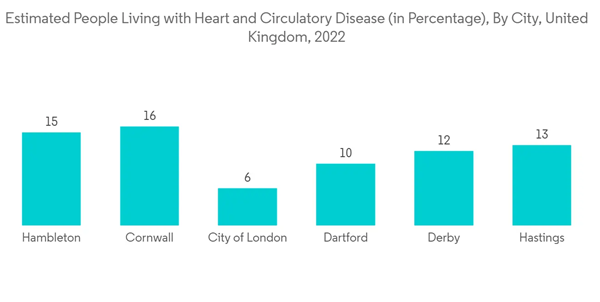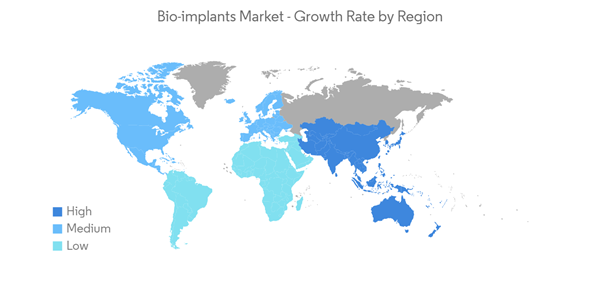The Bio-implants market is expected to register a CAGR of 8% over the forecast period.
The Covid-19 pandemic had an effect on the country's healthcare systems with significant impacts not only on the patients infected with COVID-19 but on others as well, which resulted in the cancellation of implant surgeries to manage and reserve the resources and many hospitals were facing a shortage of professionals to assist these surgeries. For instance, according to the study published in October 2021, by the National Library of Medicine globally, there has been a 42.8% decrease in general surgery admissions. Thus, the reduction in surgical procedures during the COVID-19 pandemic affected the market's growth. However, the postponed surgeries resumed worldwide, driving the market's growth during the post-pandemic period. Hence, the high number of surgical procedures and operations being performed is expected to boost the development of the bio-implant market during the forecast period.
The bio-implants market is primarily driven by the increasing burden of chronic diseases and lifestyle disorders and the rising preference toward minimally invasive surgeries. Bio-implants help in better management and specific drug delivery in conditions such as obesity, infections, and musculoskeletal disorders. For instance, bio-implants provide a unique and specific drug delivery for the skeletal system. According to an article published by Orthopaedic Surgery in January 2021, the total prevalence of lumbar spondylolisthesis in the middle-aged people of the Beijing community was 17.26% (15.98% in males and 18.80% in females). Women are more likely to suffer from lumbar spondylolisthesis after 60 years old. Furthermore, the “UK Factsheet January 2022” published in 2022 by British Heart Foundation shows that around 7.6 million people live with heart and circulatory diseases, and nearly 4 million males and 3.6 million females live with heart and circulatory diseases in the country in 2021. This highly prevalent heart and circulatory disease among patients generate demand for more implant procedures and hospital admissions.
Additionally, the increasing product launches are expected to drive the growth of the market during the forecast period. In February 2021, Medtronic launched TYRX absorbable Antibacterial Envelope- an absorbable, single-use antibacterial envelope designed to stabilize a cardiac implantable electronic device or implanted neurostimulator.
Hence, the market studied is expected to witness steady growth over the forecast period. However, the high cost of bio-implants and unfavorable reimbursement policies are expected to restrain the growth of the market.
Also, the increasing product launches are expected to drive the growth of the studied segment during the forecast period. For instance, in May 2022, Impulse Dynamics launched an optimizer smart mini. It is a rechargeable battery with heart failure monitoring that provides important clinical insights to providers to assist in managing their patients with heart failure.
Thus, owing to all the above-mentioned factors, the studied segment is expected to witness high growth over the forecast period.
Additionally, as per the Centers for Medicare and Medicaid Services, national health spending was projected to grow at an average annual rate of 5.4% from 2019-2028 and reach USD 6.2 trillion by 2028. As national health expenditure is projected to grow 1.1% points faster than the average yearly GDP over 2019-2028, the health share of the economy is projected to rise by 19.7% in 2028. Thus, the increasing healthcare spending is anticipated to create opportunities for developing bioimplants, thereby propelling market growth.
Also, the increasing product launches are expected to drive the market's growth during the forecast period. For instance, In June 2022, ZimVie launched the United States Food and Drug Administration clearing T3 pro tampered implant and Encode emergence healing Abutment in the United States.
Thus, the above-mentioned factors are expected to drive the market's growth during this region's forecast period.
This product will be delivered within 2 business days.
The Covid-19 pandemic had an effect on the country's healthcare systems with significant impacts not only on the patients infected with COVID-19 but on others as well, which resulted in the cancellation of implant surgeries to manage and reserve the resources and many hospitals were facing a shortage of professionals to assist these surgeries. For instance, according to the study published in October 2021, by the National Library of Medicine globally, there has been a 42.8% decrease in general surgery admissions. Thus, the reduction in surgical procedures during the COVID-19 pandemic affected the market's growth. However, the postponed surgeries resumed worldwide, driving the market's growth during the post-pandemic period. Hence, the high number of surgical procedures and operations being performed is expected to boost the development of the bio-implant market during the forecast period.
The bio-implants market is primarily driven by the increasing burden of chronic diseases and lifestyle disorders and the rising preference toward minimally invasive surgeries. Bio-implants help in better management and specific drug delivery in conditions such as obesity, infections, and musculoskeletal disorders. For instance, bio-implants provide a unique and specific drug delivery for the skeletal system. According to an article published by Orthopaedic Surgery in January 2021, the total prevalence of lumbar spondylolisthesis in the middle-aged people of the Beijing community was 17.26% (15.98% in males and 18.80% in females). Women are more likely to suffer from lumbar spondylolisthesis after 60 years old. Furthermore, the “UK Factsheet January 2022” published in 2022 by British Heart Foundation shows that around 7.6 million people live with heart and circulatory diseases, and nearly 4 million males and 3.6 million females live with heart and circulatory diseases in the country in 2021. This highly prevalent heart and circulatory disease among patients generate demand for more implant procedures and hospital admissions.
Additionally, the increasing product launches are expected to drive the growth of the market during the forecast period. In February 2021, Medtronic launched TYRX absorbable Antibacterial Envelope- an absorbable, single-use antibacterial envelope designed to stabilize a cardiac implantable electronic device or implanted neurostimulator.
Hence, the market studied is expected to witness steady growth over the forecast period. However, the high cost of bio-implants and unfavorable reimbursement policies are expected to restrain the growth of the market.
Bio-implants Market Trends
Cardiovascular Implants Segment is Expected to Hold the Large Share in the Bio-Implant Market Over the Forecast Period.
Bioimplants for cardiac repair require functional vascularization and innervation for proper integration with the surrounding myocardium. Bioimplants with extra-cellular vesicles from stem cells improve cardiac function after an acute myocardial heart attack. The primary factor driving the market segment's growth is the rising prevalence of cardiovascular diseases worldwide. Moreover, there is an evident rise in the geriatric population globally, which is expected to create more opportunities for the market over the forecast period. For instance, as per the article published by the American Heart Association in 2021, Approximately 40,000 children undergo congenital heart surgery in the United States each year. Such increasing prevalence of cardiovascular diseases, which led to an increasing need for early diagnosis and treatment, is expected to drive the growth of interventional cardiology procedures during the forecast period. It will drive growth in the cardiovascular implants segment. Most patients opt for heart surgery, and bioimplants can be used to treat various cardiovascular diseases.Also, the increasing product launches are expected to drive the growth of the studied segment during the forecast period. For instance, in May 2022, Impulse Dynamics launched an optimizer smart mini. It is a rechargeable battery with heart failure monitoring that provides important clinical insights to providers to assist in managing their patients with heart failure.
Thus, owing to all the above-mentioned factors, the studied segment is expected to witness high growth over the forecast period.
North America is Expected to show a Significant Growth in the Bio-implants Market
North America is found to hold a significant share of the bio-implants market and is expected to show a similar trend over the forecast period without significant fluctuations. The major factors driving the growth of the market are the increasing prevalence of chronic diseases and the presence of better healthcare infrastructure. The Centers for Disease Control and Prevention (CDC) data updated in July 2022 shows that coronary heart disease is the most common type of heart disease, and approximately 20.1 million adults of age 20 and older have the disease in the United States. Additionally, as per the CDC data, every 40 seconds, someone suffers from a heart attack, and nearly 805,000 people in the United States have a heart attack every year. The rising number of cases of chronic diseases is expected to increase the overall demand in the bio-implants market. Thus, owing to all the above-mentioned factors, the market is expected to witness a high growth rate over the forecast period.Additionally, as per the Centers for Medicare and Medicaid Services, national health spending was projected to grow at an average annual rate of 5.4% from 2019-2028 and reach USD 6.2 trillion by 2028. As national health expenditure is projected to grow 1.1% points faster than the average yearly GDP over 2019-2028, the health share of the economy is projected to rise by 19.7% in 2028. Thus, the increasing healthcare spending is anticipated to create opportunities for developing bioimplants, thereby propelling market growth.
Also, the increasing product launches are expected to drive the market's growth during the forecast period. For instance, In June 2022, ZimVie launched the United States Food and Drug Administration clearing T3 pro tampered implant and Encode emergence healing Abutment in the United States.
Thus, the above-mentioned factors are expected to drive the market's growth during this region's forecast period.
Bio-implants Industry Overview
The bio-implants market is consolidated in nature due to the presence of few companies operating. The competitive landscape includes analyzing a few well-known international and local companies that hold market shares and are famous, including Implantate AG, Abbott, Bausch & Lomb Incorporated, BIOTRONIK Inc., Edwards Lifesciences Corporation, LifeNet Health, MiMedx, Smith & Nephew PLC, and Zimmer Biomet, among others.Additional Benefits:
- The market estimate (ME) sheet in Excel format
- 3 months of analyst support
This product will be delivered within 2 business days.
Table of Contents
1 INTRODUCTION
4 MARKET DYNAMICS
5 MARKET SEGMENTATION (Market Size by Value - USD million)
6 COMPETITIVE LANDSCAPE
Companies Mentioned (Partial List)
A selection of companies mentioned in this report includes, but is not limited to:
- aap Implantate AG
- Abbott Laboratories
- Bausch & Lomb Incorporated
- BIOTRONIK Inc.
- Edwards Lifesciences Corporation
- LifeNet Health
- MiMeDX
- Smith & Nephew PLC
- Zimmer Biomet
- Boston Scientific Corporation
- Stryker Corporation
- Endo International Plc
Methodology

LOADING...










